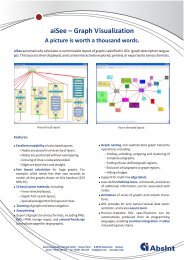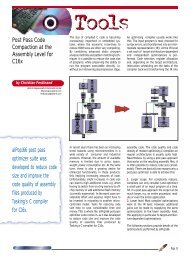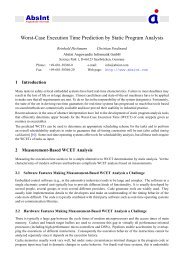5 Graph Description Language (GDL) - Absint
5 Graph Description Language (GDL) - Absint
5 Graph Description Language (GDL) - Absint
You also want an ePaper? Increase the reach of your titles
YUMPU automatically turns print PDFs into web optimized ePapers that Google loves.
• Gravitational forces<br />
The problem with spring forces is that they are only effective in connected graphs. In unconnected<br />
graphs simulating a spring embedder makes unconnected nodes move away from one<br />
another as there are only repulsive forces but no attractive forces. That is why gravitational<br />
forces are introduced. All nodes are attracted to the bary center of all the other nodes.<br />
• Simulated annealing<br />
The simulated annealing model is oriented to the physical process of annealing, which often<br />
leads to very regular structures (e.g. like crystals).<br />
A global energy level is computed for a graph which is the sum of all energy levels of the<br />
nodes. The energy level at a node is determined from the forces acting it, much like the<br />
elongation of the springs. The spring embedder tries to minimize the global energy level by<br />
moving the nodes in the direction of the forces.<br />
Nodes are randomly moved so as to avoid being trapped at a local energy minimum. At the<br />
beginning this is done more vigorously, with random movement being ceased towards the<br />
end in order to stabilize the final layout. The amount of random movement depends on the<br />
”temperature”, which is controlled by a temperature scheme.<br />
aiSee also supports the concept of local temperatures for a node. The temperature takes the<br />
local situation of the graph into account (see energetic graph attribute, p. 70) and regulates<br />
how much and how often a node is randomly moved.<br />
The force-directed placement algorithm consists of four phases:<br />
• Initialization phase<br />
• First iteration phase<br />
• Optional second iteration phase<br />
• Final improvement phase<br />
The two iteration phases are conceptionally the same. They simply sequentially simulate the two<br />
magnetic fields acting on the system. The second iteration phase is omitted if there is only one<br />
magnetic field.<br />
One iteration phase consists of a loop of iteration steps that are executed until the global temperature<br />
value has fallen below a specified threshold value or until a maximum number of iterations is<br />
reached.<br />
In each iteration step the new impulses of the nodes (force directions) are calculated, the nodes<br />
moved to their new positions according to the impulses, and the global temperature adjusted.<br />
In the final improvement phase, the node positions can be rastered. This is done by moving a node<br />
to its closest raster point after each iteration step.<br />
Finally the minimum x and y coordinates are calculated and the entire layout is moved so that<br />
the minimum coordinates are just zero. This step is necessary because all nodes move during the<br />
iteration phase, meaning they could have all moved away from the origin of the coordinate system.<br />
Finally the start and end points of the edges are calculated.<br />
For more details, see [Sa96].<br />
116





